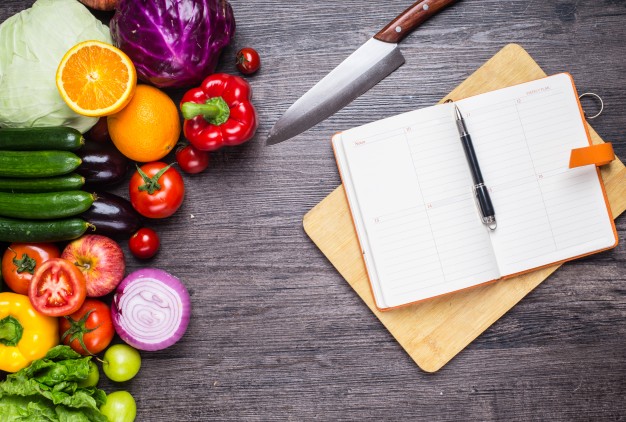Planning a menu and family meals does require time, but it’s a small investment with huge rewards! Some of the benefits of menu planning include:
- Money savings
- Time savings
- Reduced impulse purchases
- Reduced food waste
1. Get inspired
Your Pinterest board is flooded with recipes you’ve been meaning to try, and don’t you still have unopened cookbooks on your bookshelf? These are great places to start. Pick a few recipes that you and your family would enjoy and think about when you want to eat them.
2. Get organized
Now that you’ve got some inspiration, it’s time to organize it. This step is two-fold. Getting organized requires you to write down the meals you want to create and the ingredients needed to turn those meals into a reality. It doesn’t need to be fancy; you can use your calendar, a note pad, or a simplified menu planner like this one from Kizingo. The point of this step is to organize the new recipes you want to try, the staples you eat in your diet, and the family favourites. They all have a place in your weekly meal plan.
Once you’ve decided on what you’ll be making, a grocery list needs to be drafted. This will guide the shopping and ensure only the necessary ingredients are purchased. I always organize my grocery lists based on the store or market floor plan, so shopping can be done based on each category: produce, grains, dairy/alternatives, meat/alternatives, pantry items, and freezer items.
3. Get shopping
You’re ready. It’s time to shop! Equipped with an organized and detailed list, shopping for ingredients to make healthy, nutritious meals, will be faster! Time savings starts now, money savings comes next. You are only shopping for items that fit into your family’s menu plan, so you won’t come home with unnecessary impulse purchases.
4. Get prepping
Right after shopping, get into the kitchen. This is the best time to prep. Instead of putting your groceries into the fridge, take the time to wash produce items with a veggie wash, so they are ready to go! I generally leave my veggies to soak, because it allows me to multitask and get on with the rest of the food prep. There are lots of produce washes on the market (honest, fit, among others) and it's also simple to make yourself.
Here are two easy recipes for veggie washes:
Veggie Spray:
1 TBSP lemon juice or 5 drops (food grade) lemon EO
2 TBSP white vinegar
1 CUP water
Veggie Soak:
- 3:1 ratio of water to white vinegar and 2-3 drops (food grade) lemon EO
Prepare components of your meals such as making sauces, cooking grains and proteins, and chopping produce. Take the time to batch cook or double some of the recipes you choose, so your hard work can be enjoyed right away, and have leftovers to stock your freezer.
5. Get eating
Now it’s time to enjoy the benefits! Weekday meals will be faster because you’ll know what you’ll be eating and part (or all) of it will be prepared. This meals you will end up spending less time in the kitchen cooking. Leftovers? Not to worry. These make great lunch options.
With menu planning, every ingredient shopped for has a purpose. Foods won’t be tossed out at the end of the week since each item has been incorporated into the menu plan. This also means money savings, and who doesn’t like that?
I hope you’ve found these tips and tricks helpful, and encouraged you to consider menu planning for you and your family. For more information and individual consultation, NutriKidz is here to help!




